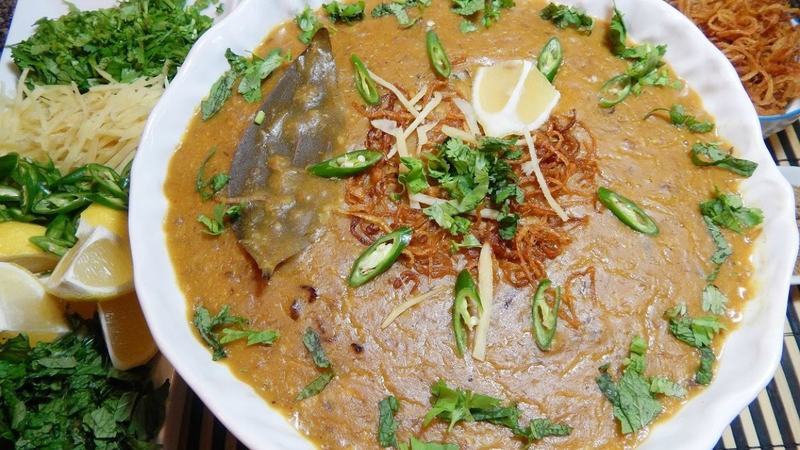Cooking Recipes

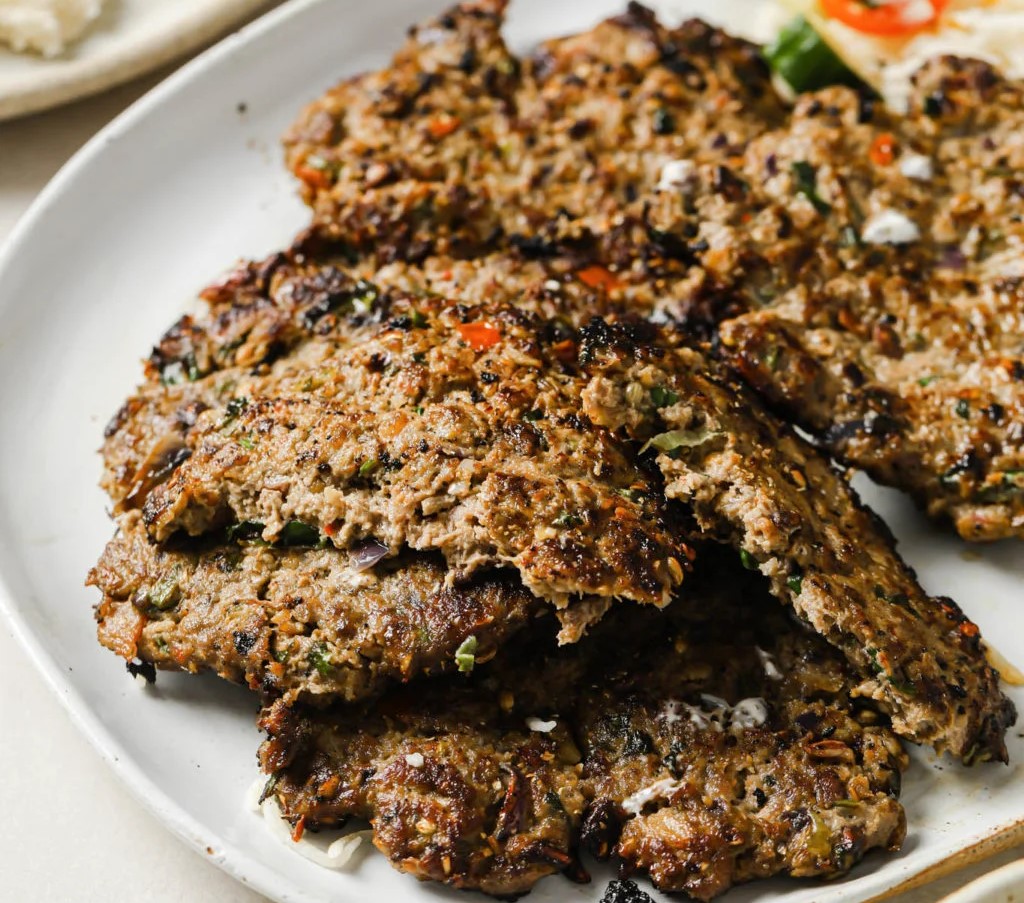
INGREDIENTS IN CHAPLI KABAB
Only two of the required ingredients warrant a trip to the Desi Grocery Store:
Dried Pomegranate seeds (Anardana): These are a key ingredient that help make Chapli Kabab..well..Chapli Kabab. They add a slight tang and crunch. I love adding the full 2 tablespoons (more than most recipes!) but you can decrease to one tablespoon to make them more subtle.
If you positively don’t like the crunch, a great substitute is 2-3 teaspoons of pomegranate powder or even pomegranate molasses.
Corn Flour (Makki ka atta) or Gram flour (Besan): Helps bind the kababs while enhancing the taste. Though some authentic recipes insist corn flour (which is like cornmeal but finer) is the only way to go, I know gram flour/besan (different from chickpea flour) is much more likely to already be in your pantry. Plus, I tested it & they both work perfectly well.
HOW TO MAKE CHAPLI KABAB
Toast & grind the spices. Toasting deepens the flavor while removing the raw taste of the spices. Add them to a spice grinder (or even a food processor) along with the pomegranate seeds. Roughly crush.
Toast the corn flour or gram flour. Again, enhances the nutty flavor of the corn flour. You can probably get away with not toasting, but I toast. It takes 5 minutes. You can do it. Or not. Follow your heart on this one.
Combine all the ingredients in a bowl, including the prepped ones above. Mix/knead the dough vigorously until you can see the stringy texture of the meat. You can also use the paddle attachment of a stand mixer to do this.
Fry! There are 2 ways to do this. The first one is obvious. Shape into patties. But, if you can, smash them directly on the pan.
Serve immediately with a sprinkle of ground coriander and cilantro.
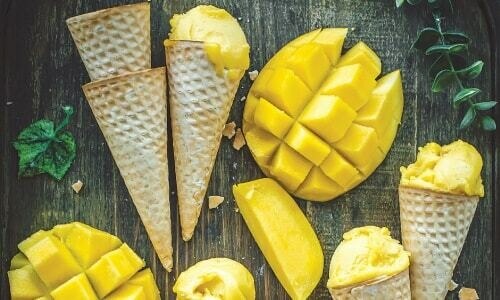
Recipe
1 can (397g/14 oz) of condensed milk (use 2/3 of the can if you like your ice cream less sweet)
2 packets or 400 ml cream
2-3 cups mango, chopped
1 cup of mango, small chopped pieces for topping (optional)
Steps
Mix all the ingredients in a blender. First mix the condensed milk and cream. Then add in the cut mango pieces and blend again. Pour into a plastic or steel container. Add in cut mango pieces and stir in if desired. Put in the freezer overnight and serve generous scoops in a cone or bowl.
There’s something nostalgic about ice cream and summers. For those of us growing up in the ’90s in Karachi, just the mention of the two evokes memories of digging into a Polka cup of vanilla or chocolate with its wooden spoons or heading to Snoopy’s with the family to share a sundae. Grabbing an ice lolly or a choc bar from the school canteen or cart is such a common childhood memory, it’s become a movie trope. And who doesn’t remember sneaking in an extra crunch kulfi at a party or wedding?
For my parents’ generation, memories of the kulfi loom large. My mom fondly recalls evenings spent waiting for the kulfiwala on his pushcart: “We’d all run out when we’d hear the bell on his cart ringing. He was this really sweet man and I remember he’d deftly move this wooden stick around in a metallic box to scoop out kulfi.”
While upscale franchises and gelato parlours now crowd the frozen foodscape, in the ’50s, ’60s and ’70s it was homegrown ice-cream eateries such as Baloch Ice Cream and Peshawari Ice Cream, both founded in the late 1940s, that were the places to go.
Of course, most people are still fond of places they visited in their childhood. A friend loyally still frequents a small stall in Bahadurabad that sells soft serve in only two flavours: coffee and vanilla.
Indulge yourself with no-churn mango ice cream this summer
“I’d go shopping with my mom, aunt and cousin to Tariq Road, and we’d have Crazy Cone ice cream on the way back. It’s one my favourite memories,” she says.
Nothing makes me more nostalgic than the home-made ice cream my nani [maternal grandmother] would churn out each summer — in Karachi that’s pretty much the whole year — and you’d frequently find chocolate ice cream sprinkled with caramelised almonds in her freezer.
As a young girl, I remember helping out my nani — I’m sure she’ll disagree with how much I actually helped — make batches of chocolate ice cream as the summer would start. I’d watch fascinated as cocoa powder and milk transformed into a thick, silky texture, the seductive smell of chocolate permeating the kitchen.
I’d sit transfixed, as the ice cream machine hummed and churned, my nani knowing exactly when was the right time to pour the next bit of the batch. She’d always fuss over the ice-cream maker, inspecting every part before putting it together, making sure everything was poured in exactly the right amount. There was a certain rhythm to making ice cream and she’d mastered it.
Sadly, I’ve never come close to making chocolate ice cream taste as good as hers. While she tried to help me, my nani officially retired from all kitchen duties more than a decade ago. Luckily, I’ve had more success with a no-churn version I discovered a few years ago, and happily stock my freezer with flavours made from whatever fruit is in season.
Of course, until I master my nani’s recipe, I’ll continue to be seduced by ice cream’s allure. But then again who isn’t?
No-Churn Mango Ice Cream
Nothing beats mango ice cream during the summer. There’s something so cooling and indulgent about this dessert. And the best part? No fussy machine is needed and it takes 10 minutes to prepare. The ice cream usually freezes within six hours, but it’s best to freeze overnight.
While I’ve made mango ice cream here, the recipe can be substituted with any fruit that has a lot of fibre, such as strawberry or cheeku [sapodilla]. For strawberry ice cream, pick slightly sour ones for a great tart but sweet flavour. It’s best to choose sweet cheeku and, for mango, go crazy with all the different kinds on offer throughout the summer — my favourite flavours are with Sindhrri and Anwar Ratol.
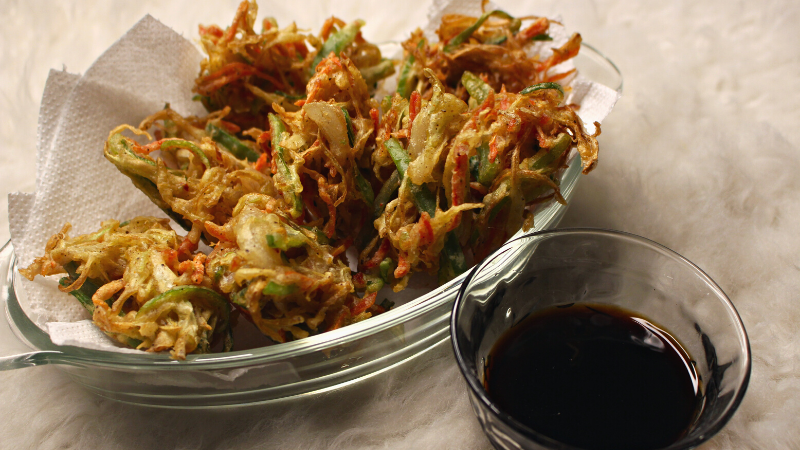
Here's how you can make this simple yet flavourful dish for your iftar.
Ingredients
- 1 to 1 and 1/2 cup carrots
- 1 to 1 and 1/2 cup cabbage
- 1/2 cup capsicum
- 1/2 cup onion
- 1/4th or 1/2 cup green onions
- 1/4th cup ginger (optional)
- 3 to 4 green chillies
All vegetables to be cut in thin long strips, julienne style.
- 1/2 cup tempura mix
- 1/2 cup corn flour
- 2 tbsp all-purpose flour
- 1 tsp salt
- 1 tsp black pepper
- 1/2 tsp chilli flakes
- 1 egg (optional)
- cold water to mix dry ingredients
Method - Add the vegetables in a bowl. Mix it well so when you add it to the frying pan you get equal amounts of vegetables in each fritter. You can add more vegetables such as radish, mushrooms and eggplant.
- Keep the mixed vegetables and the batter in separate bowls. This will allow you to increase or reduce the quantity when mixing the vegetables and batter together.
- In a separate bowl add dry ingredients and an egg. Then add spices such as chilli flakes, salt, black pepper and white pepper (optional).
- Start mixing it and slowly add cold water into the batter until it develops a medium consistency. Make sure it's not too thick or too runny.
- Separate the vegetables in a bowl and add as much as you need at that time. Slowly pour in the batter, making sure that it sticks to the vegetable mix. Adding vegetables all at once will make the mixture watery, hence I suggest you mix it in in batches.
- Use a tablespoon to scoop out the mixture and add it in a pre-heated wok with oil. Make sure to fry on medium-high heat until golden brown.
- Once fried, take them out on a metal grill or serving dish for the oil to separate and then they are ready to be served. Avoid using kitchen towel or tissue to soak the oil as it makes the fritters soggy.
- However, you can lay the tissue on the serving dish to catch the oily residue.
Serve with teriyaki sauce or sweet chilli sauce and enjoy!
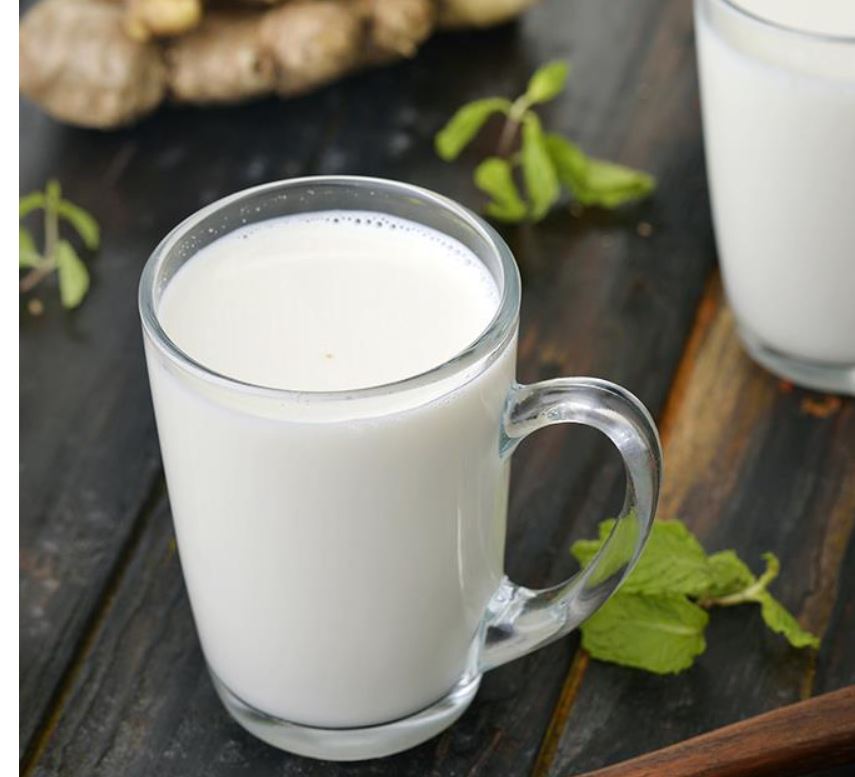
Ingredients
2 Cups Milk
2 table spoons Roughly chopped ginger / ADRAK
1.5 table spoons Sugar or as per your taste
Method
Step-1: Combine all the ingredients in a deep pot, mix it well and cook on medium flame for 5 to 6 minutes.
Step 2: Strain the mixture
Step 3: Pour the milk into 4 individual Glasses and serve.
Nutrient Values Per Glass
Energy 141 Cal.
Protein 4.3g
Carbohydrates 11g
Fat 6.5g
Cholesterol 16mg
Sodium 19mg
Ingredients
1 cup wheat
¼ cup plus 1 tbsp barley
¼ cup white maash (urud) dal
¼ cup moong dal
¼ cup masoor dal
¼ cup basmati rice
1 cup channa dal
½ to ¾ cup oil
2 ½ lbs preferably boneless veal or beef stew (without fat), mutton and chicken can be used as well
1 ½ cup chicken or beef stock
1 ½ heaped tablespoon red chilli powder (increase or decrease according to taste if needed)
Salt to taste
2 to 3 tablespoons ginger garlic paste,
1 tablespoon heaped coriander powder
1 ½ teaspoon level turmeric powder
1 ½ large onions sliced for frying
Ingredients for sealed pot cooking
1 level teaspoon garam masala powder, ¼ teaspoon nutmeg powder, ¼ teaspoon mace powder, ½ teaspoon black cumin, ½ teaspoon green, cardamom powder
Ingredients for Garnish or served on the side
Lemon wedges, chopped cilantro and green chillies, fried onions, julienned ginger, chaat masala, yoghurt and naan.
Method
Wash and soak all seven grains for 6 to 8 hours. In a pan, fry onions until golden-brown, adding meat, ginger, garlic, chilli powder, turmeric, coriander powder, stock and salt. Cook until korma is tender.
In a large separate pot, boil pre-soaked grains until tender, approximately for 2 to 2 ½ hours.
Eyeball the water quantity (for boiling and cooking) depending on the required consistency and thickness of the haleem.
Once boiled, put grains in blender and blend roughly, pouring the blended grains back in the pot for cooking.
Repeat the blending process with the meat korma, pouring the roughly blended korma into the cooking grains.
Mix thoroughly on low to medium flame, stirring constantly.
Cook and stir until the correct consistency, tasting for salt and chilli content. The haleem must be well blended.
Now add all five sealed-pot ingredients and mix well. Seal the pot and let steam for a few minutes.
Garnish and serve with a side of naan, if desired. This one is a sure-shot hit — nothing short of a professionally made street-food deghi haleem. Enjoy.
The writer is a journalist and her debut novel *Feast, With A Taste of Amir Khusro is up for release this Autumn*
------------------------------------------------------------------
During my wonder years, the 10th of Muharram meant a pulao degh being made at my parents’ home, and a haleem degh at my nani’s. Needless to say the haleem was delicious — hot, spicy, flavourful and (for a child) consumable only with a few bottles of soda. However as I entered my teens, my tolerance for spice went up and my appreciation for haleem went up even further.
I have been researching South Asian foods for some years now, and my fascination for our cuisine grows with time. Our foods have travelled regions, jumped cuisines, evolved and survived the test of time, hence earning an elite status amongst the cuisines of the world, and haleem is one such dish.
It is said to be one of the original “generosity dishes”, meaning it was always prepared with the intention of sharing with others. It is believed that the recipe of Middle Eastern harissa, written millennia ago, is what haleem actually evolved from. Harissa, according to food historian Claudia Roden is the parent of haleem and is believed to be an Arab specialty rather than a Muslim one.
Haleem is said to be one of the original “generosity dishes”, meaning it was always prepared with the intention of sharing with others
The medieval Andalusian Jews ate it on Saturdays, a day of Sabbath for them. The Lebanese and Syrian Christians make harissa to celebrate the Feast of the Assumption. And in Iraq, Lebanon and the subcontinent, Shia Muslims made it to commemorate the martyrdom of Imam Hussain at Karbala in the month of Muharram.
It was perhaps Mughal Emperor Humayun who brought the recipe of haleem to the subcontinent, but apparently it was his son Akbar who made it popular across the board, from troops to the throne. It is originally a slow-cooking dish and its name in Arabic even means ‘patience’.
Here is something interesting that I stumbled upon some years ago when researching the history of haleem.
Ciezadlo in her article History on a Plate, quotes in the article Food Stories, Haleem:
“In the late 7th century, Caliph Mu’awiya of Damascus, received a delegation of Arabian Yemenis. According to medieval historians who wrote about the encounter, the Caliph’s first question to his visitors addressed something more urgent than political matters. Years earlier, on a journey to Arabia, he had eaten an exquisite dish, a porridge of meat and wheat. Did they know how to make it? They did.
It was perhaps Mughal Emperor Humayun who brought the recipe of haleem to the subcontinent, but apparently it was his son Akbar who made it popular across the board, from troops to the throne
"The first written recipe of harissa [haleem], dates from the 10th century, when a scribe named Ibn Sayyar al-Warraq compiled a cookbook of the dishes favored by the caliphs. The version described in his Kitab al-Tabikh (Book of Dishes), the world’s oldest surviving Arabic cookbook, is strikingly similar to the one people in the Middle East eat to this day.”
This Muharram, I am torn between making pulao like my mother did, or haleem like my nani did. Maybe I’m going to end up making both. That’s not such a bad idea after all.
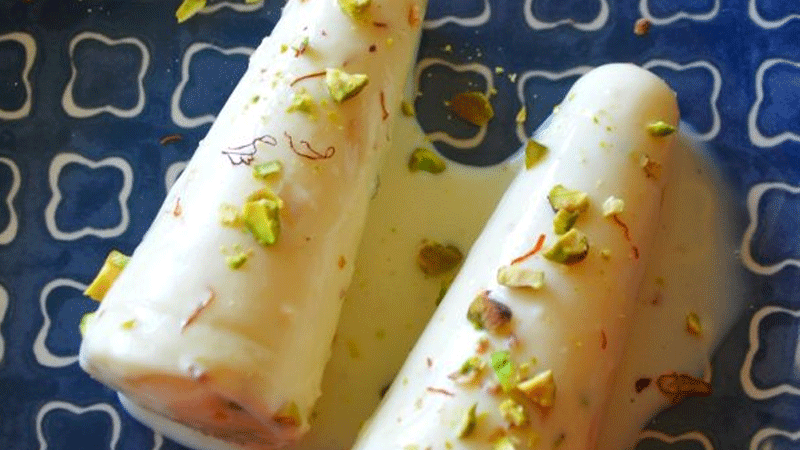
Saffron is the most expensive spice in the world. We aren’t arguing that fact, however.
Ingredients
2 litres whole milk
1 cup heavy cream
3/4 cup sugar
1 tsp cardamom
4 to 5 tsp corn starch, dissolved in 2 tbsp of water
1 tbsp rose water
2/3 cup pistachio, chopped
A pinch of saffron dissolved in 1 tbsp of milk
Method
Soak saffron strands in one tablespoon of milk and set aside. In a separate bowl dissolve cornstarch in water and let it rest. Pour milk in a heavy-lidded pan to boil. Once it comes to a boil, lower the flame and let the milk thicken. Half an hour in, add the cornstarch, saffron and sugar to the simmering milk. Stir the dissolved cornstarch before adding to the milk, and keep stirring while doing so. Add cream and pistachios and keep stirring. Let simmer for an hour and a half, or until desired thickness is reached. Add cardamom powder, rose water and switch off the flame.
Let the mixture cool completely and pour into kulfi moulds. Freeze overnight. Your saffron kulfi is ready.
And why is that?
Because it takes 75,000 flowers to make one pound of saffron, and the flower is said to bloom only one week of the year. No wonder the spice is said to be priced as much as gold — maybe not literally, but almost.
My first recollection of being introduced to saffron is from the jingle of Zahoor Zaafrani Patti Tambakoo. This catchy jingle holds a bell for all those born between the 1950s and the 1970s. However, what’s never been established is that was saffron really an ingredient in this two-bit chewing tobacco product? A mystery yet to be solved, and one that makes me chuckle.
One of the myths surrounding the origin of saffron tells the tale of the Greek god Hermes, where he accidentally killed his friend Crocus, and whose spilling blood germinated saffron. God only knows how this can be true; all we know is that Hermes products now are also worth their weight in gold, or saffron.

Beautiful, war-ravaged Kashmir is one of the places where saffron is cultivated. The spice and its mehek (fragrance) is a big part of the dishes included in Kashmiri wazwaan, and is the oomph factor in it. However, it is said that it was first cultivated in Greece and then further moved east to Morocco, Iran, Turkey and Japan in Asia, and to Spain in Europe. Currently, Iran is said to be the largest producer of the spice.
Saffron is a magical spice, and having experienced its aroma there is one thing I know about it for sure, it’s hard to describe it. If I had to, I’d say it’s a smell that has a taste.
According to Sarah Salkin, an editor at cookstr.com, “Wherever saffron is grown, foods have been developed to showcase its magic: The French have bouillabaisse, the Italians have Risotto Milanese, the Spanish have paella, the subcontinent has biryani, curry and kulfi and Iran has a whole host of saffron-infused dishes. And saffron can be added to any number of plain foods to make them magical. But in order to make the most of saffron, you need to know how to handle the precious threads. The secret is infusion.”
Like tea leaves, saffron threads have to be infused in hot water for maximum fragrance — usually for 30 minutes or so, a few threads in eight to 10 ounces of water, or any other liquid, hot milk, broth, etc.

Sitting at a Kashmiri family friend’s dinner table, I learnt an interesting little anecdote about the spice. Uncle Rasheed Mir, while passing a platter of Roghan Josh, said to me, “A Spanish dish will taste perfect when made with Spanish saffron, while a Kashmiri dish is best flavoured with saffron cultivated in Kashmir.”
Saffron is high in riboflavin and vitamin B and has long been acknowledged for its medicinal uses. Europeans used it to treat the common cold and cough, and ancient Persians thought it to be an aphrodisiac. I don’t know about it being an aphrodisiac, but I do know that there is nothing as delicious as the zaafrani kulfi, and here it is from my kitchen to yours.
Zaafrani Kulfi
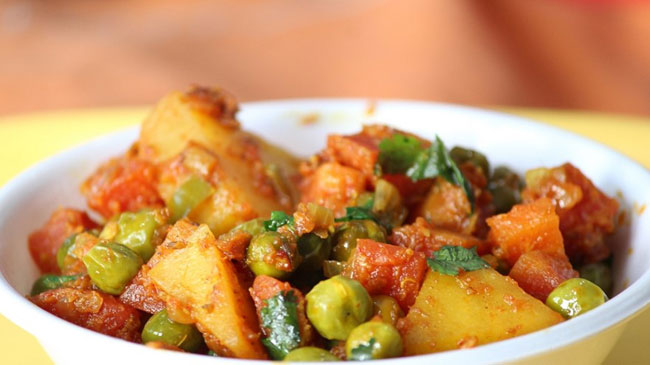
GAJAR, MATAR, AALO SABZI
INGREDIENTS
2 cups chopped potatoes
2 cups chopped carrots
1 cup frozen or fresh peas
1 teaspoon cumin seeds
1 teaspoon mustard seeds
1 onion, chopped
1 tomato, chopped
1 green chilli, finely chopped
½ teaspoon turmeric powder
½ teaspoon garam masala
1 teaspoon amchoor powder
Salt to taste
4 to 5 tablespoons oil (or as desired)
Curry leaves
Garnish with chopped coriander, lemon wedges and green chillies
METHOD
Heat oil, add cumin, curry leaves, mustard seeds, turmeric, onions, fry for a few minutes and toss in the vegetables. Cover and cook for 15 to 20 minutes on medium heat, stirring and spraying with water, periodically, once vegetables are tender, add all the masalas, cook for a few minutes, garnish and serve.
GAJAR KA HALWA (SERVES 10 TO 12)
INGREDIENTS
1 kg carrots (orange)
1 ½ to 2 litres of milk
½ pint Half-and-Half
1/3 pint heavy whipping cream
1 ¾ cups sugar
2 to 3 tablespoons butter (unsalted)
¼ cup oil
8 to 10 cardamoms
1 tablespoon raisins
2 tablespoons blanched and chopped almonds
METHOD
Lightly peel and grate carrots and set aside. Bring milk to boil and add the carrots, let the milk and carrot mixture come to a boil then add half-and-half and sugar, stirring constantly. Keep stirring until the mixture comes to boil, reducing heat to medium. Once the milk evaporates (should take one-and-a-half to two hours) add heavy cream, stirring constantly. Once cream evaporates, add butter, oil and cardamoms stirring constantly, keeping the flame medium to high. Keep stirring until oil separates, and the colour is a rich beautiful deep orange. Garnish with raisins and almonds and serve.
CARROT JUICE
INGREDIENTS
2 pounds carrots, chopped
4 or more cups water
1 can condensed milk, or malai with sugar (I prefer it with condensed milk)
Dash of nutmeg/cinnamon or green cardamom
1 teaspoon vanilla
½ teaspoon fresh ginger
METHOD
Blend carrots in a blender, adding water; sieve through mulmul (muslin) cloth. Squeeze extracting all juice, discard the pulp and pour the juice into the blender, adding all ingredients. Puree and serve hot or chilled.



